How to use the NORM.DIST function
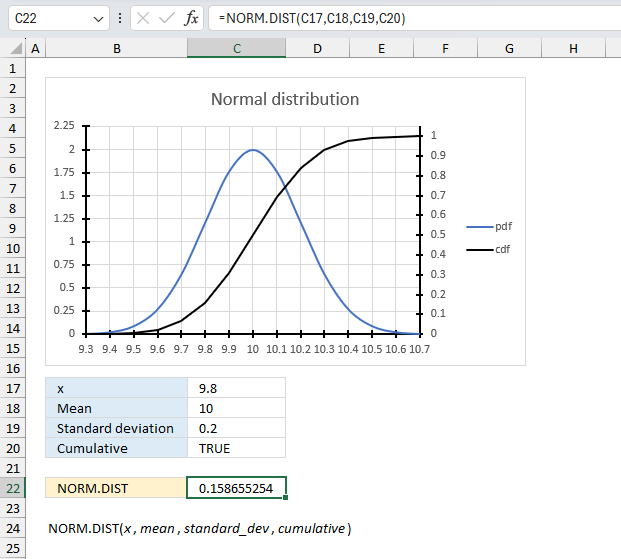
What is the NORM.DIST function?
The NORM.DIST function calculates the normal distribution for a given mean and standard deviation.
Table of Contents
1. Introduction
What is a normal distribution?
The normal distribution is a symmetric bell-shaped probability distribution described by its mean and standard deviation. Used by many to model a plethora of natural phenomena and represent unknown processes.
What is the mean?
It is also known as the average. It is calculated by adding up all the values in the data set and dividing by the number of values.
For example, if you have a data set of 5, 7, 9, 11, and 13, the mean is (5 + 7 + 9 + 11 + 13) / 5 = 9.
What is deviation?
In statistics, deviation is a measure of how far each value in a data set lies from the mean (the average of all values). A high deviation means that the values are spread out widely, while a low deviation means that they are clustered closely around the mean.
What is standard deviation?
Standard deviation measures dispersion from the mean by taking the square root of the average of squared deviations, useful for assessing variability and spread in data.
What is the difference between deviation and standard deviation?
- Deviation is the difference between an individual data point and the mean.
- Standard deviation measures the variation across all deviations by using the square root of the average squared deviation.
What is the difference between the NORM.DIST function vs NORM.INV function?
NORM.INV function returns the inverse of the normal cumulative distribution for a given mean and standard deviation.
NORM.INV(probability, mean, standard_dev)
The NORM.DIST function calculates the normal distribution for a given mean and standard deviation.
NORM.DIST(x, mean, standard_dev, cumulative)
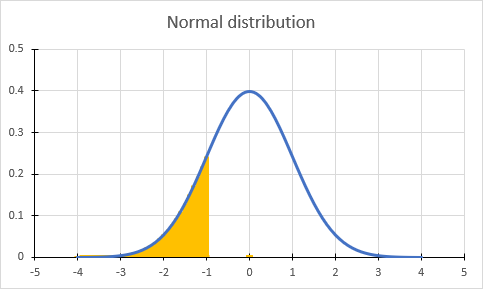
For example, the chart above demonstrates a normal distribution with a mean of 0 (zero) and standard deviation of 1.
The NORM.DIST(-1,0,1,TRUE) returns 0.158655253931457 which is the orange area below the curve up to x = -1 that represents the cumulative probability.
The NORM.INV(0.158655253931457,0,1) returns -1 which is the x value given the probability of 0.158655253931457
What is a standard normal distribution?
A standard normal distribution is a normal distribution with the mean of 0 (zero) and the standard deviation is 1. You can standardize any normal distribution using the STANDARDIZE function in Excel, it works like this:
z = (x - µ)/σ
z = z-score
µ is the mean.
σ is the standard deviation.
2. Syntax
NORM.DIST(x, mean, standard_dev, cumulative)
3. Arguments
| x | Required. A number to calculate the distribution for. |
| mean | Required. The average of the distribution. |
| standard_dev | Required. The standard deviation of the distribution. |
| cumulative | Required. A boolean value that determines which distribution the NORM.DIST function returns. TRUE - Cumulative distribution FALSE - Probability mass function |
If mean = 0, standard_dev = 1, and cumulative = TRUE, the standard normal distribution is returned.
If cumulative = TRUE, the formula is calculated the integral from negative infinity to x.
What is the probability mass function?
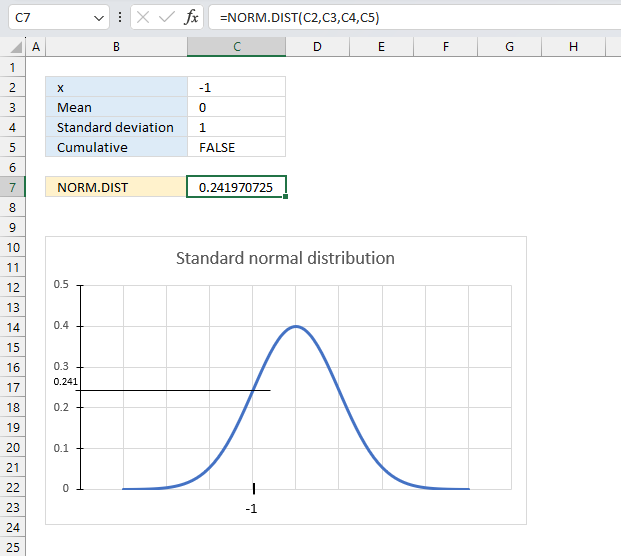
NORM.DIST with the cumulative parameter set to FALSE returns the value of the probability density function which is the value at the y-axis for a given x-axis value. The image above shows the y value 0.24197 for x-axis value -1.
NORM.DIST(-1,0,1,FALSE) returns approx. 0.24197
NORM.DIST(-1,0,1,TRUE) returns approx. .15866 which is the integral from negative infinity to -1
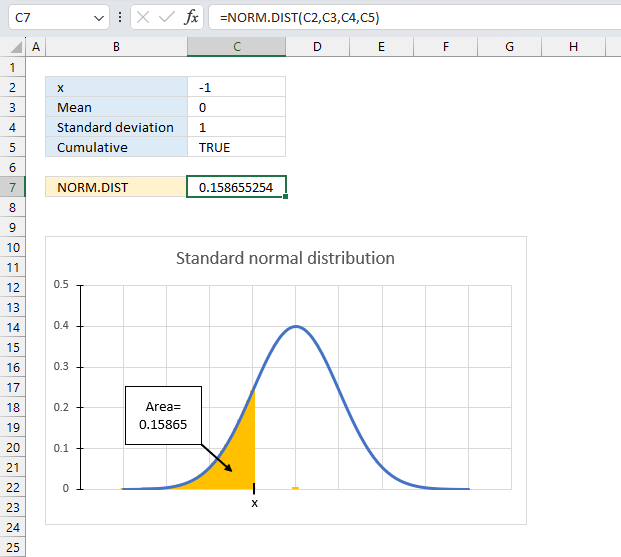
The image above shows the integral from negative infinity to x axis value -1.
4. Example 1

In a manufacturing process, the diameter of a particular component follows a normal distribution with a mean of 10 mm and a standard deviation of 0.2 mm. What is the probability that a randomly selected component will have a diameter less than 9.8 mm?
The arguments are:
- x = 9.8 mm
- mean = 10 mm
- standard_dev = 0.2
- Cumulative = True
These arguments are specified in cells C17,C18,C19,and C20 respectively, in the image above.
The image above shows a chart containing a blue curve representing the probability mass function of a normal distribution where the mean is 10 and the standard deviation is 0.2. The black curve represents the cumulative distribution based on the same mean and standard deviation as described above.
Formula in cell C22:
The formula returns 0.159 which represents the area below the blue curve between 0 (zero) and x= 9.8.
In the image above, locate the value 9.8 on the x-axis. From that point, draw an imaginary vertical line upwards until it intersects with the black curve, which represents the cumulative distribution function. Then, follow the point of intersection horizontally towards the y-axis to the right. You will find that the corresponding value on the y-axis is approximately 0.159.
5. Example 2
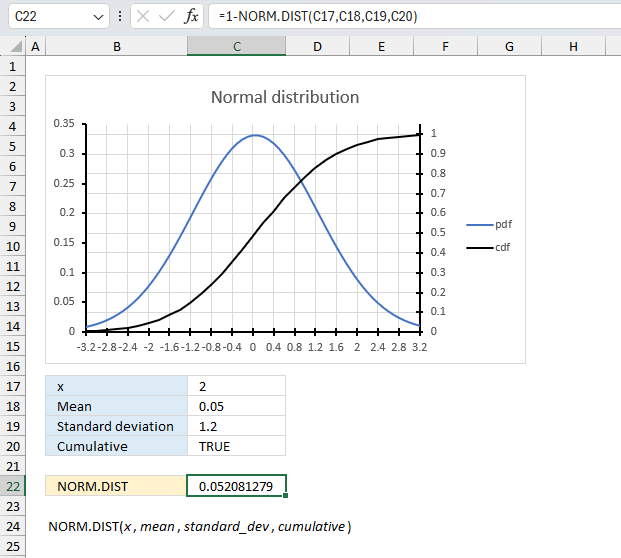
The daily returns of a particular stock follow a normal distribution with a mean of 0.05% and a standard deviation of 1.2%. What is the probability that the daily return will be greater than 2%?
The arguments are:
- x = 2 %
- mean = 0.05 %
- standard_dev = 1.2%
- Cumulative = True
These arguments are specified in cells C17,C18,C19,and C20 respectively, in the image above.
The image above shows a chart containing a blue curve representing the probability mass function of a normal distribution where the mean is 0.05 and the standard deviation is 1.2. The black curve represents the cumulative distribution based on the same mean and standard deviation as described above.
Formula in cell C22:
The formula returns 0.052 (5.2%) which represents the area below the blue curve between x= 2 and infinity.
In the image above, locate the value 2 on the x-axis. From that point, draw an imaginary vertical line upwards until it intersects with the black curve, which represents the cumulative distribution function. Then, follow the point of intersection horizontally towards the y-axis to the right. You will find that the corresponding value on the y-axis is approximately 0.95. This value represents the area below the blue curve between x = 0 and x = 2, however, we need the area below the blue curve from x=2 to x = infinity. We need to calculate the complement to get the correct value.
6. Function not working

The NORM.DIST returns a
- #VALUE! error value if the mean or standard_dev is non-numeric.
- #NUM! error value if standard_dev ≤ 0
- #NAME? error if you misspell the function name.
- propagates errors, meaning that if the input contains an error (e.g., #VALUE!, #REF!), the function will return the same error.
6.1 Troubleshooting the error value

When you encounter an error value in a cell a warning symbol appears, displayed in the image above. Press with mouse on it to see a pop-up menu that lets you get more information about the error.
- The first line describes the error if you press with left mouse button on it.
- The second line opens a pane that explains the error in greater detail.
- The third line takes you to the "Evaluate Formula" tool, a dialog box appears allowing you to examine the formula in greater detail.
- This line lets you ignore the error value meaning the warning icon disappears, however, the error is still in the cell.
- The fifth line lets you edit the formula in the Formula bar.
- The sixth line opens the Excel settings so you can adjust the Error Checking Options.
Here are a few of the most common Excel errors you may encounter.
#NULL error - This error occurs most often if you by mistake use a space character in a formula where it shouldn't be. Excel interprets a space character as an intersection operator. If the ranges don't intersect an #NULL error is returned. The #NULL! error occurs when a formula attempts to calculate the intersection of two ranges that do not actually intersect. This can happen when the wrong range operator is used in the formula, or when the intersection operator (represented by a space character) is used between two ranges that do not overlap. To fix this error double check that the ranges referenced in the formula that use the intersection operator actually have cells in common.
#SPILL error - The #SPILL! error occurs only in version Excel 365 and is caused by a dynamic array being to large, meaning there are cells below and/or to the right that are not empty. This prevents the dynamic array formula expanding into new empty cells.
#DIV/0 error - This error happens if you try to divide a number by 0 (zero) or a value that equates to zero which is not possible mathematically.
#VALUE error - The #VALUE error occurs when a formula has a value that is of the wrong data type. Such as text where a number is expected or when dates are evaluated as text.
#REF error - The #REF error happens when a cell reference is invalid. This can happen if a cell is deleted that is referenced by a formula.
#NAME error - The #NAME error happens if you misspelled a function or a named range.
#NUM error - The #NUM error shows up when you try to use invalid numeric values in formulas, like square root of a negative number.
#N/A error - The #N/A error happens when a value is not available for a formula or found in a given cell range, for example in the VLOOKUP or MATCH functions.
#GETTING_DATA error - The #GETTING_DATA error shows while external sources are loading, this can indicate a delay in fetching the data or that the external source is unavailable right now.
6.2 The formula returns an unexpected value

To understand why a formula returns an unexpected value we need to examine the calculations steps in detail. Luckily, Excel has a tool that is really handy in these situations. Here is how to troubleshoot a formula:
- Select the cell containing the formula you want to examine in detail.
- Go to tab “Formulas” on the ribbon.
- Press with left mouse button on "Evaluate Formula" button. A dialog box appears.
The formula appears in a white field inside the dialog box. Underlined expressions are calculations being processed in the next step. The italicized expression is the most recent result. The buttons at the bottom of the dialog box allows you to evaluate the formula in smaller calculations which you control. - Press with left mouse button on the "Evaluate" button located at the bottom of the dialog box to process the underlined expression.
- Repeat pressing the "Evaluate" button until you have seen all calculations step by step. This allows you to examine the formula in greater detail and hopefully find the culprit.
- Press "Close" button to dismiss the dialog box.

There is also another way to debug formulas using the function key F9. F9 is especially useful if you have a feeling that a specific part of the formula is the issue, this makes it faster than the "Evaluate Formula" tool since you don't need to go through all calculations to find the issue..
- Enter Edit mode: Double-press with left mouse button on the cell or press F2 to enter Edit mode for the formula.
- Select part of the formula: Highlight the specific part of the formula you want to evaluate. You can select and evaluate any part of the formula that could work as a standalone formula.
- Press F9: This will calculate and display the result of just that selected portion.
- Evaluate step-by-step: You can select and evaluate different parts of the formula to see intermediate results.
- Check for errors: This allows you to pinpoint which part of a complex formula may be causing an error.
The image above shows cell reference C17 converted to hard-coded value using the F9 key. The NORM.DIST function requires numerical values which is not the case in this example. We have found what is wrong with the formula.
Tips!
- View actual values: Selecting a cell reference and pressing F9 will show the actual values in those cells.
- Exit safely: Press Esc to exit Edit mode without changing the formula. Don't press Enter, as that would replace the formula part with the calculated value.
- Full recalculation: Pressing F9 outside of Edit mode will recalculate all formulas in the workbook.
Remember to be careful not to accidentally overwrite parts of your formula when using F9. Always exit with Esc rather than Enter to preserve the original formula. However, if you make a mistake overwriting the formula it is not the end of the world. You can “undo” the action by pressing keyboard shortcut keys CTRL + z or pressing the “Undo” button
6.3 Other errors
Floating-point arithmetic may give inaccurate results in Excel - Article
Floating-point errors are usually very small, often beyond the 15th decimal place, and in most cases don't affect calculations significantly.
7. How is the function calculated?
The NORM.DIST function is very useful if you are working with statistics. Here is how the function works in detail (cumulative = FALSE).
µ is the mean.
σ is the standard deviation.
Use the AVERAGE function to calculate the arithmetic mean, used in the second argument in the NORM.DIST function.
Recommended articles
What is the AVERAGE function? The AVERAGE function calculates the average of numbers in a cell range. In other words, […]
Use the STDEV.P function to calculate the standard deviation used in the third argument.
Recommended articles
What is the STDEV.P function? The STDEV.P function returns standard deviation based on the entire population. STDEV.P is an abbreviation […]
'NORM.DIST' function examples
The following article has a formula that contains the NORM.DIST function.
Table of Contents How to graph a normal distribution How to build an arrow chart How to graph an equation […]
Functions in 'Statistical' category
The NORM.DIST function function is one of 73 functions in the 'Statistical' category.


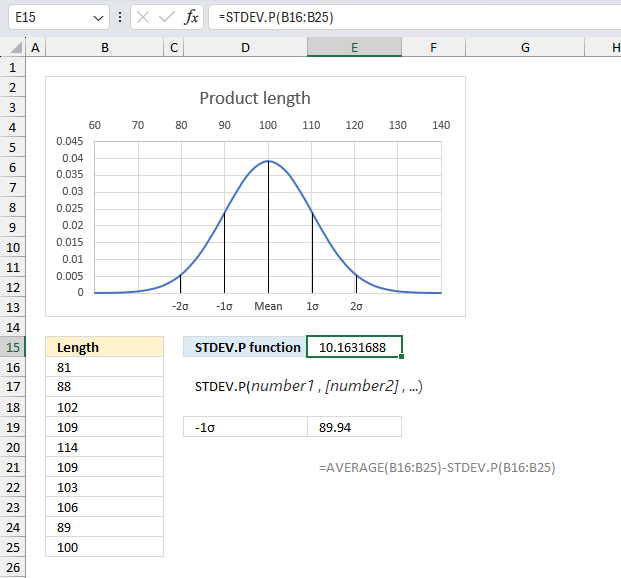
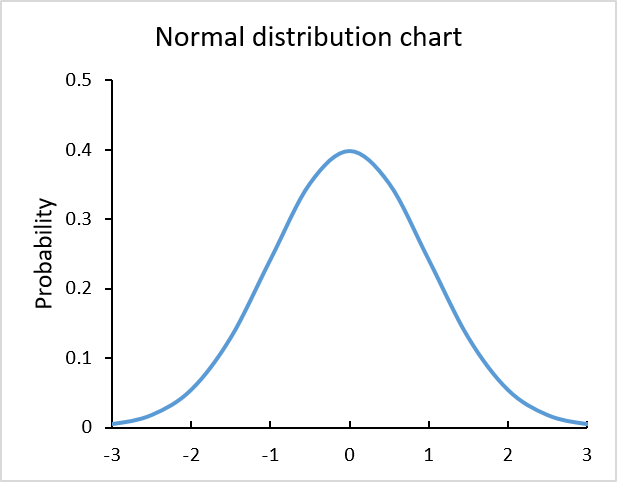
How to comment
How to add a formula to your comment
<code>Insert your formula here.</code>
Convert less than and larger than signs
Use html character entities instead of less than and larger than signs.
< becomes < and > becomes >
How to add VBA code to your comment
[vb 1="vbnet" language=","]
Put your VBA code here.
[/vb]
How to add a picture to your comment:
Upload picture to postimage.org or imgur
Paste image link to your comment.
Contact Oscar
You can contact me through this contact form